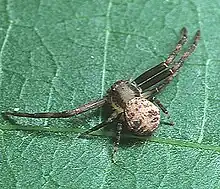| Ebelingia | |
|---|---|
 | |
| E. kumadai, juvenile | |
| Scientific classification | |
| Domain: | Eukaryota |
| Kingdom: | Animalia |
| Phylum: | Arthropoda |
| Subphylum: | Chelicerata |
| Class: | Arachnida |
| Order: | Araneae |
| Infraorder: | Araneomorphae |
| Family: | Thomisidae |
| Genus: | Ebelingia Lehtinen, 2004[1] |
| Type species | |
| E. kumadai (Ono, 1985) | |
| Species | |
Ebelingia is a genus of Asian crab spiders consisting of two species separated from Mecaphesa due to their distinct abdominal pattern and the unique color pattern of their body and legs.[2] As of April 2022 it contains three species found throughout Asia: E. forcipata, E. hubeiensis and E. kumadai.[1]
See also
References
- 1 2 "Gen. Ebelingia Lehtinen, 2004". World Spider Catalog Version 20.0. Natural History Museum Bern. 2020. doi:10.24436/2. Retrieved 2020-10-07.
- ↑ Lehtinen, P. T. (2004), "Taxonomic notes on the Misumenini (Araneae: Thomisidae: Thomisinae), primarily from the Palaearctic and Oriental regions", in Logunov, D. V. (ed.), European Arachnology 2003 (Proceedings of the 21st European Colloquium of Arachnology, St
Further reading
- Kim, S. T.; Lee, S. Y. (2012). "Arthropoda: Arachnida: Araneae: Thomisidae. Thomisid spiders". Invertebrate Fauna of Korea. 21 (9): 1–88.
- Ono, H. (2009). The spiders of Japan with keys to the families and genera and illustrations of the species. Tokai University Press, Kanagawa. p. 739.
- Namkung, J. (2003). The Spiders of Korea (2nd ed.). Kyo-Hak Publishing Co., Seoul. p. 522.
This article is issued from Wikipedia. The text is licensed under Creative Commons - Attribution - Sharealike. Additional terms may apply for the media files.